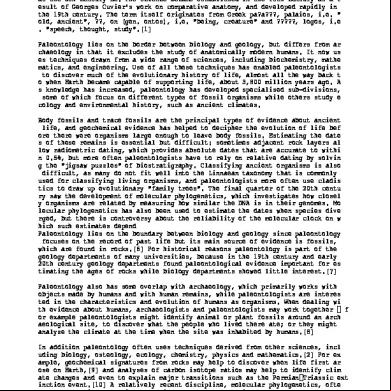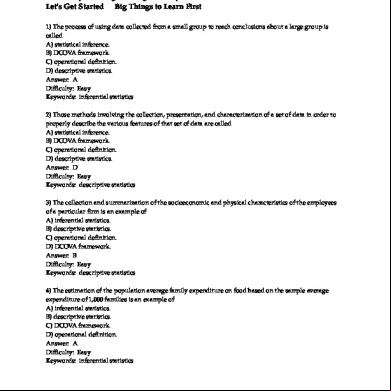Therde 24u4t
This document was ed by and they confirmed that they have the permission to share it. If you are author or own the copyright of this book, please report to us by using this report form. Report 3b7i
Overview 3e4r5l
& View Therde as PDF for free.
More details w3441
- Words: 797
- Pages: 2
Paleontology or palaeontology (pronunciation: /?pe?li?n't?l?d?i/, /?pe?li?n't?l? d?i/ or /?pæli?n't?l?d?i/, /?pæli?n't?l?d?i/) is the scientific study of life that e xisted prior to, and sometimes including, the start of the Holocene Epoch (rough ly 11,700 years before present). It includes the study of fossils to determine o rganisms' evolution and interactions with each other and their environments (the ir paleoecology). Paleontological observations have been documented as far back as the 5th century BC. The science became established in the 18th century as a r esult of Georges Cuvier's work on comparative anatomy, and developed rapidly in the 19th century. The term itself originates from Greek pa?a???, palaios, i.e. " old, ancient", ??, on (gen. ontos), i.e. "being, creature" and ?????, logos, i.e . "speech, thought, study".[1] Paleontology lies on the border between biology and geology, but differs from ar chaeology in that it excludes the study of anatomically modern humans. It now us es techniques drawn from a wide range of sciences, including biochemistry, mathe matics, and engineering. Use of all these techniques has enabled paleontologists to discover much of the evolutionary history of life, almost all the way back t o when Earth became capable of ing life, about 3,800 million years ago. A s knowledge has increased, paleontology has developed specialised sub-divisions, some of which focus on different types of fossil organisms while others study e cology and environmental history, such as ancient climates. Body fossils and trace fossils are the principal types of evidence about ancient life, and geochemical evidence has helped to decipher the evolution of life bef ore there were organisms large enough to leave body fossils. Estimating the date s of these remains is essential but difficult: sometimes adjacent rock layers al low radiometric dating, which provides absolute dates that are accurate to withi n 0.5%, but more often paleontologists have to rely on relative dating by solvin g the "jigsaw puzzles" of biostratigraphy. Classifying ancient organisms is also difficult, as many do not fit well into the Linnaean taxonomy that is commonly used for classifying living organisms, and paleontologists more often use cladis tics to draw up evolutionary "family trees". The final quarter of the 20th centu ry saw the development of molecular phylogenetics, which investigates how closel y organisms are related by measuring how similar the DNA is in their genomes. Mo lecular phylogenetics has also been used to estimate the dates when species dive rged, but there is controversy about the reliability of the molecular clock on w hich such estimates depend Paleontology lies on the boundary between biology and geology since paleontology focuses on the record of past life but its main source of evidence is fossils, which are found in rocks.[6] For historical reasons paleontology is part of the geology departments of many universities, because in the 19th century and early 20th century geology departments found paleontological evidence important for es timating the ages of rocks while biology departments showed little interest.[7] Paleontology also has some overlap with archaeology, which primarily works with objects made by humans and with human remains, while paleontologists are interes ted in the characteristics and evolution of humans as organisms. When dealing wi th evidence about humans, archaeologists and paleontologists may work together f or example paleontologists might identify animal or plant fossils around an arch aeological site, to discover what the people who lived there ate; or they might analyze the climate at the time when the site was inhabited by humans.[8] In addition paleontology often uses techniques derived from other sciences, incl uding biology, osteology, ecology, chemistry, physics and mathematics.[2] For ex ample, geochemical signatures from rocks may help to discover when life first ar ose on Earth,[9] and analyses of carbon isotope ratios may help to identify clim ate changes and even to explain major transitions such as the Permian Triassic ext inction event.[10] A relatively recent discipline, molecular phylogenetics, ofte n helps by using comparisons of different modern organisms' DNA and RNA to re-co nstruct evolutionary "family trees"; it has also been used to estimate the dates
of important evolutionary developments, although this approach is controversial because of doubts about the reliability of the "molecular clock".[11] Technique s developed in engineering have been used to analyse how ancient organisms might have worked, for example how fast Tyrannosaurus could move and how powerful its bite was.[12][13] It is relatively commonplace to study fossils using X-ray mic rotomography[14] A combination of paleontology, biology, and archaeology, paleon eurology is the study of endocranial casts (or endocasts) of species related to humans to learn about the evolution of human brains.[15] Paleontology even contributes to astrobiology, the investigation of possible lif e on other planets, by developing models of how life may have arisen and by prov iding techniques for detecting evidence of life.[16]
of important evolutionary developments, although this approach is controversial because of doubts about the reliability of the "molecular clock".[11] Technique s developed in engineering have been used to analyse how ancient organisms might have worked, for example how fast Tyrannosaurus could move and how powerful its bite was.[12][13] It is relatively commonplace to study fossils using X-ray mic rotomography[14] A combination of paleontology, biology, and archaeology, paleon eurology is the study of endocranial casts (or endocasts) of species related to humans to learn about the evolution of human brains.[15] Paleontology even contributes to astrobiology, the investigation of possible lif e on other planets, by developing models of how life may have arisen and by prov iding techniques for detecting evidence of life.[16]





